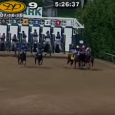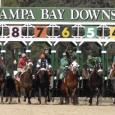
Raven’s Pass (photo via www.breederscup.com)
The Breeders’ Cup presents the ultimate handicapping challenge. Big fields coming together from all over the US and Europe test, to the breaking point, the usual handicapping basics of class, speed and pace. You can’t ignore the basics, as these are still just horse races. And getting away from what you do every other race day is a sure way to get lost — and a sure way to turn what should be two glorious days of play into 48 hours of frustration and loss.
On the other hand, there is the matter of projecting performances across geography and jurisdiction that, in amplitude and importance, is unique to this set of races. If you don’t have a way of determining which runners can carry their games across the country or halfway across the globe, you are going to be lost. Your handicapping is going to be lacking and your confidence will soon follow.
So, toward avoiding that end, what follows is a guide to coping with one of thorniest Breeders’ Cup handicapping issues: how to evaluate European shippers.
The approach I am going to lay out is three-tiered. The first level is conceptual, even a bit fanciful. It’s a metaphor for what to look for from Euro shippers. The second level girds the first. It’s what the races and performances and sets of races and performances look like that give rise to our general concept. The third level is the lynchpin — an indispensable characteristic of the final European prep, which, when lacking, makes victory in the Breeders’ Cup unlikely.
Our level one discussion starts with one word for the handicapper: momentum.
In going from Europe to the Breeders’ Cup in North America, competitors not only cross an ocean, and, this year, a continent, but they also traverse racing worlds. That being the case, the first question we have to consider is can they get here from there?
The answer has to do with the momentum they have built. We can think of it like space travel and how NASA uses the gravitational slingshot effect to speed and direct spacecraft. For us, a horse’s European preps are all about whether they have built the necessary momentum to propel it to the winner’s circle. What we don’t want are horses that appear to be declining or runners that have already fired their best shots in pursuit of some other primary goal.(1)
It might be helpful, before we continue, for the reader to take a moment and mull over what the past performances of a properly prepared contender might look like…
What I hope you envisioned was a series of races wherein our subject horse(s) maintained, if not built on, progressive form. Going back to our metaphor, this series of races is the gravitational body. It is our rock. It might be still evolving. It may have come to an end in August or early September. Keep in mind, we are concerned with momentum. Do not fall into the trap of handicapping absolute or relative ability. Class matters, but only cases where a subject has shown no ability to compete at a Grade/Group I level, or lacks sufficient momentum to propel itself to a new level of performance. (2010 Turf winner Dangerous Midge is the type of horse not to disregard; questionable on class, but with a number of explosive wins against lesser including his final prep).
Forwardly moving juveniles should never be dismissed on class grounds.
Distance and change of distances, within common sense handicapping bounds, is of little importance. Euros can and have stretched out from as short as a mile to win at our classic distance (Banks Hill 2001, Raven’s Pass 2008).(2)
They have also cut back from European marathons (Red Rocks 2006). Juveniles can stretch out from as short as six furlong races to go the flat mile or even 1 1/16 miles (Johannesburg).(3)
Now, what you may not have pictured as an essential part of the kind of momentum I am talking about is what the guts of the running lines should look like — the crucial evidence we need to show that our horse is going to slingshot out of his races like that spacecraft I alluded to earlier.(4)
We absolutely do not want a horse that lost ground or position in his final prep. We want to see our runners leaving others in their wakes. This is a required element of the final prep. And it should be duplicated elsewhere in the race series. By the nature of what we value, these are mostly off-the-pace efforts. However, it is a positive sign, although not a requirement, when we see a runner within its series of preps show a flash of speed.(5)
Finally we come to the lynchpin, the key to determining which Euros demonstrate sufficient momentum to propel them to victory at the Breeders’ Cup. We call it the “Euro Zoom.” The Euro Zoom is when a horse gains at least three positions during the running of a race without falling back from the most prominent position it achieves. In general, we want to see a top three finish, but that requirement is subject to common sense.
Shirocco, for instance, zoomed from eighth to fourth in a 15-horse Arc field in his prep for his winning bid in the 2005 Turf. The one exception is the high class stalker who chases and passes at least two runners on the way to victory (think Sakhee and Goldikova as examples of the last).
If you have old Breeders’ Cup Forms or you can find the past performances online, I urge you to go back and check them out. You’ll see the Euro Zoom is a characteristic of virtually every winning European shipper. Daylami did win the 1999 Turf off a dismal Arc run over very soft going and, High Chaparral did run evenly over heavy going at Longchamp before repeating in 2003, but notice the nature of the efforts they put in immediately prior to their final preps.
Good luck in the Breeders’ Cup and may the momentum be with you!
(1) There is a reason Arc winners have underperformed in the Breeders’ Cup. They have usually reached their intended destination. Sakhee dominated his Arc off a brief freshening. Between his easy win and the fact his connections were aiming for the Classic his terrific effort against Tiznow makes sense. Found will present an interesting case if she defends her Turf title. She zoomed to win the Arc, but she looks like she was prepared specifically for that moment and I thought her momentum waned near the wire. I will be against her to repeat if she comes. But I will also expect her to run well.
(2) Raven’s Pass was prepared magnificently. “Plastics!” No, it was momentum. He would have beaten Curlin anywhere in the world on any type of surface that day.
(3) Johannesburg’s past performances leading up to his Juvenile win were great — six win and six Zooms.
(4) Frustratingly, our past performances in the US are becoming less comprehensive when it comes to European running lines. You may have to watch replays where you can find them to recreate the running or wait until RacingPost.com posts the Breeders’ Cup cards to have the best sense of how the races were run. I suggest writing into your PPs three or four positional points of call in each race for the Europeans.
(5) Not to beat a winning horse, but Raven’s Pass’ preparation by trainer John Gosden included an easy penultimate prep in which he dropped the Kentucky-bred son of Elusive Quality into an easy Grade II spot. There, he cast aside his closing style in a wire-to-wire win.



